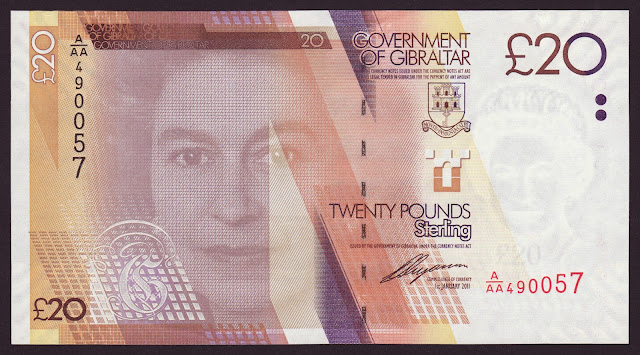Gibraltar Banknotes 20 Pounds banknote 2011 Queen Elizabeth II
Issued by The Government of Gibraltar
Obverse: Portrait of Her Majesty Queen Elizabeth II and Capital letter "G". Coat of arms of Gibraltar at right. Dated 1 January 2011. Signature of Dilip Dayaram Tirathdas (as Commissioner of Currency). Windowed security thread with demetalized text on front. One horizontal and one vertical 6-digit serial number (both with nurmerals of ascending size) with fractional prefix.
Reverse: HMS Victory returning to Gibraltar 1805. Admiral Lord Nelson called at the port of Gibraltar on a number of occasions prior to the famous Battle of Trafalgar of 1805, fought close to Gibraltar, where he won a great victory but lost his life. The back of the £20 banknote shows the dismasted HMS Victory, the Admiral's flagship, being towed to Gibraltar after the battle, bearing the body of the dead Admiral.
Original size: 149 x 80 mm.
Printer: Thomas De La Rue & Company Limited, London England.
Portrait of Queen Elizabeth II., electrotype £20 and cornerstones as watermark.
Gibraltar banknotes - Gibraltar paper money
2010-2011 Issue
HMS Victory
HMS Victory, flagship of the victorious British fleet commanded by Admiral Horatio Nelson in the Battle of Trafalgar on Oct. 21, 1805. The ship is preserved today as a historic relic at Portsmouth, England.
HMS Victory, launched at Chatham in 1765, was a 100-gun ship of the line with a length of 186 feet (57 m), a displacement of 2,162 tons, and a crew of more than 800 men. As a flagship of Britain’s Channel and Mediterranean fleets during the American Revolution and French Revolutionary wars, the ship saw extensive action against France and its allies. In 1778 under Admiral Augustus Keppel, and again in 1781 under Richard Kempenfelt, it led engagements near the island of Ushant (Ouessant). In 1782 it flew the flag of Admiral Richard Howe in the relief of a besieged garrison at Gibraltar, and in 1793 it served under Admiral Samuel Hood during a brief occupation of Toulon, Fr. In 1797 the Victory was the flagship of Admiral John Jervis in his destruction of a Spanish fleet off Cape Saint Vincent, Port.
At the Battle of Trafalgar the Victory’s flags gave Nelson’s famous signal “England expects that every man will do his duty.” The Victory itself engaged two French ships of the line; from the topmast of one a sniper fired the shot that mortally wounded Nelson, who died in the ship’s cockpit in the midst of battle. After carrying Nelson’s body home, the Victory continued to aid in Britain’s continental blockade during the Napoleonic Wars. By the 1830s the ship had been dismasted and moored at Portsmouth, Eng., as a stationary flagship of the naval command. There it remained until 1922, when it was placed in dry dock and restored to its condition under Nelson. The ship and an attached maritime museum have attracted tourists since 1928.
Participated in: First Battle of Ushant (1778); Second Battle of Ushant (1781); Battle of Cape Spartel (1782); Battle of Cape St Vincent (1797); Battle of Trafalgar (1805); Status: Active, Flagship of the First Sea Lord.

